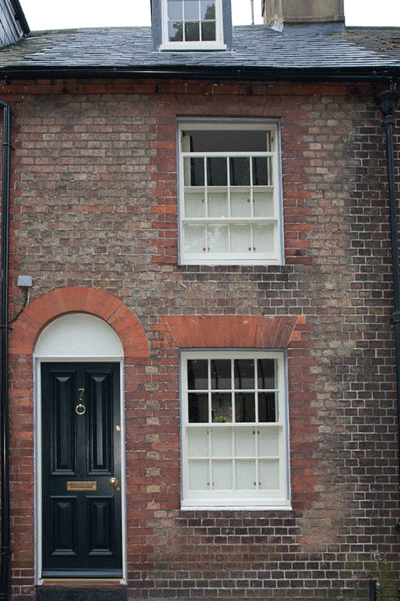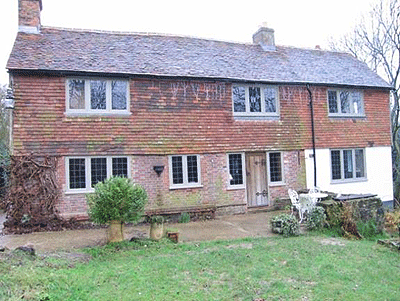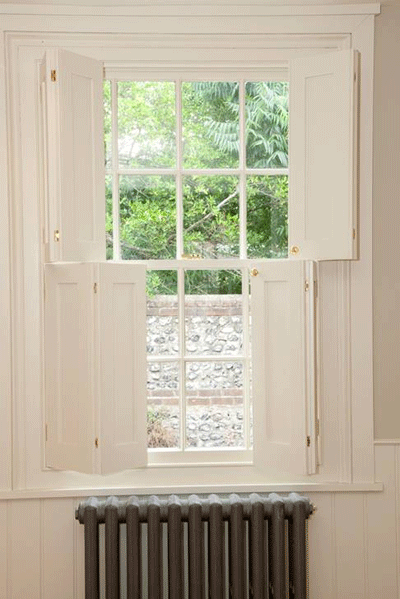Replacing windows on period properties
Replacing your windows to make them more energy efficient is one of the most desirable changes you can make to your period house

Replacing the windows in your period property represents a substantial investment which requires a great deal of thought and extensive research. New windows can transform the appearance, security and comfort of your home and, if accomplished with sensitivity and understanding, can represent a significant improvement which tends to increase the value of a property.
Before embarking upon such a project, as with any other significant alteration to your property, it is important to reflect on the reasons for making the change and what you hope to achieve from your investment.
Upgrading thermal performance - saving money and the environment
Heating and constructing buildings in the UK accounts for 50% of our energy consumption. The by-products of that energy use are carbon dioxide and sulphur dioxide emissions from power stations and it is these by-products that are contributing to global warming. In order to meet its commitment to reduce CO2 emissions under the Kyoto Agreement, the Government made the replacement of windows and doors in your home subject to the requirements of Building Regulations in England and Wales.

Victorian villa in Hastings where the original sliding box sash windows were replaced with wooden double glazd alternatives, using slimmer 14mm krypton-filled units to enable the replication of the fine glazing bars
These changes are designed to improve the thermal efficiency of our homes and set insulation standards (measured in units of thermal transmittance or ‘U-value'), which tend to favour double rather than single glazing. Double glazing works by trapping air between two panes of glass creating an insulating barrier that reduces heat loss, noise and condensation. The thermal performance, or U-value of a replacement window can be increased by upgrading the glass type, filling the cavity with gas or adding sheets of glass to create triple glazing. New technology is constantly being introduced into the UK market and one of the latest developments is slimmer double glazed units which meet the requirements of Building Regulations. These can be used in traditional style Georgian or Victorian type designs enabling the glazing bars and section sizes to replicate the slimmer appearance of the original windows.
Window frames can be manufactured in a variety of materials but, interestingly, aluminium and uPVC do not perform as well as timber in terms of thermal efficiency. Both involve a much greater consumption of energy in their production than is used to produce timber. Wood, as a natural renewable resource is clearly preferable to any man-made alternative and can be repaired and renovated over time. To further increase insulation, opening sashes should be draught-proof.
Exquisite houses, the beauty of Nature, and how to get the most from your life, straight to your inbox.
By retrofitting existing homes with modern insulating, energy-saving and even energy-generating technology we can improve our eco-credentials. To join the campaign and find out more information go to www.thegreatbritishfurb.co.uk or visit the Act on CO2 campaign at www.energytrust.org.uk.
Maintenance issues - windows are rotten and/or do not work properly
Wood has been the natural choice for windows for centuries and there are many excellent examples of wooden windows which are over 100 years old and still perfectly serviceable today. Wood is a natural renewable resource and, when adequately and appropriately maintained, can give many years of useful service. Additionally, when wooden windows show signs of weathering, they can be sympathetically repaired to extend their life. This option is not available with man-made alternatives which will fade and discolour over a period of time.
Inevitably, however, windows reach the point where they are beyond repair and require replacement. At which time it may be possible to incorporate modern technology to upgrade their performance whilst maintaining the aesthetic appearance of the originals. Alternatively, you may wish to take the opportunity to replace the windows with something that is more in keeping with the period of the building.
To ensure that you achieve the maximum life from any external joinery including windows, it is very important to instigate a regular maintenance routine which will involve inspection and cleaning on a quarterly basis after the final protective covering (paint or stain) has been applied in accordance with the paint manufacturers' instructions. Additionally, to enable sliding sash windows to operate smoothly, apply a silicon spray or candle wax to the pulley stiles regularly and always treat your windows with care by avoiding slamming them shut or forcing them open.

Replacement of sliding sash box windows in a terraced property in Lewes, East Sussex
Aesthetic improvement - replacing mismatched windows, plastic or aluminium
The UK has a rich tradition of using different window designs and materials from various periods of history and the loss of original windows in historic buildings can ruin the appearance of the building. Occasionally buildings are subjected to unsympathetic renovation and replacements which are functional rather than aesthetic or, through several renovations under different ownership, have mismatched windows that are not in keeping with each other or with the property itself. In this instance, not only will the property benefit from consistency but also the replacements might actually increase the value of the property whilst improving its appearance. It is always worth checking with an expert such as a local surveyor or estate agent before making your investment as it has been found that, in some instances, plastic replacement windows, rather than wooden, can actually reduce the value of your home when it comes to resale.

This property in Heathfield had windows of different styles in aluminium and painted wood. These were replaced with hardwood casement style windows glazed with traditionally hand-made leaded light glass
Renovation - reinstatement of windows that match the age of property and the original design
Custom-made manufacturers of joinery can replicate the original design of the windows in your property and, if these windows no longer exist, can use those in the neighbouring properties or those shown in old photographs to inform the design of the replacements. Details such as the style and section size of the glazing bars, the use of mouldings, the style of the horns on sliding sash windows and the use of traditional weights and cords and the style and finish of the ironmongery can all be incorporated within the design.
In the terraced cottage in Lewes shown below, the property was located within the Conservation area of the town and single glazed replacements were the preference of the property owner and Conservation Officer. To improve thermal efficiency and enhance privacy and security, double sets of timber shutters were designed and fitted to all of the windows.

Replacing windows in historic buildings
We all recognise the need to conserve the natural environment by reducing heat loss. This presents an ethical dilemma for architectural conservationists and homeowners alike as a balance needs to be struck between the requirements for energy efficiency and the preservation of our architectural heritage. Replacing any windows in your property now requires Building Regulations approval from your District Council, even if a like-for-like replacement is being made. Where the existing windows are beyond repair and require replacement, it may be possible to incorporate double glazing into the replacements without significantly compromising the character and appearance of the building.
Conservation Areas and Listed Buildings
Listed buildings are protected by law and it is necessary to obtain listed buildings consent by making an application to your local council to change the design, method of opening or material of the window. As a general rule, Listed Buildings consent is rarely given for replacement double glazed windows in listed properties even when the windows are to be constructed to replicate the originals. Compensatory measures can be taken to increase energy efficiency in other parts of the building such as roof or floor insulation, thermally lined curtains or secondary glazing.

Replacement windows in a listed property in Wivelsfield Green
For properties located in Conservation areas, permission for aesthetic and functional changes rests with your local Conservation Officer and their advice should always be sought prior to the installation. They will advise on whether a Planning Application is necessary. In either case, a Building Notice application is a requirement and should be made in addition to other consents. Building Control monitor building work to ensure that it meets safety requirements and is up to permitted standards and they will inspect the windows prior to their replacement and follow up with a further inspection after the work has been completed. They will then issue a certificate of compliance which will be required when you sell your property. A charge will be made for this service which is usually a percentage of the cost of the building work. If you are permitted to replace your windows with double glazed alternatives a FENSA regulated company can self-certify their own work and a Building Notice application will be unnecessary.
FENSA registered businesses are required to understand the Regulations and be capable of installing a product in your home which meets these requirements. They will be in a position to advise you on the design and installation of windows and doors in your home to ensure compliance and thus avoid problems which may occur when you eventually sell your home.
Improving security - insurance concerns
Statistics indicate that one third of all burglers gain access to properties through the windows. Double glazing provides some security in that it is harder to break than single glazing. Glazing beads are difficult to remove but it is recommended, as a precautionary measure, that these should be glued and pinned for additional security. Because the noise of breaking glass could alert neighbours and passersby to criminal activity, easing open the sashes on a window is a preferable means of undetected entry and, therefore, lockable ironmongery should be fitted to all replacements.
Before instructing your contractor, check with your insurance company to see if there are additional security measures that you can specify which, whilst in the short term may increase the cost of your installation, may, in the long term, prove cost effective in the savings made on your household insurances. It is recommended that lockable stays and fasteners should be fitted to casement windows and, for additional security, casement locks. On sliding sash windows, lockable sash fasteners should be fitted together with sash stops.
Located close to the historic town of Lewes in East Sussex, Parsons Joinery Ltd, has built an excellent local reputation for quality joinery and efficient service. Our customer base beyond the local market to include West Sussex, Kent and London working for architects, designers, building contractors and private individuals. For more information, please visit www.parsonsjoinery.com
Parsons Joinery Ltd is a member of ProjectBook.

ProjectBook has been created to help owners of listed or period properties understand how their buildings work and to help them find appropriate craftsmen, products and specialist information. The online Heritage Register contains over 540 registered businesses, the largest directory of its type in the UK. For more information, visit www.projectbook.co.uk.
Follow ProjectBook on Twitter
Country Life is unlike any other magazine: the only glossy weekly on the newsstand and the only magazine that has been guest-edited by His Majesty The King not once, but twice. It is a celebration of modern rural life and all its diverse joys and pleasures — that was first published in Queen Victoria's Diamond Jubilee year. Our eclectic mixture of witty and informative content — from the most up-to-date property news and commentary and a coveted glimpse inside some of the UK's best houses and gardens, to gardening, the arts and interior design, written by experts in their field — still cannot be found in print or online, anywhere else.
